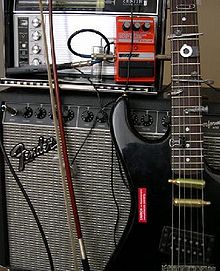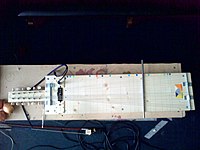Prepared guitar
This article has multiple issues. Please help improve it or discuss these issues on the talk page. (Learn how and when to remove these template messages)
|

A prepared guitar is a guitar that has had its timbre altered by placing various objects on or between the instrument's strings, including other extended techniques. This practice is sometimes called tabletop guitar, because many prepared guitarists do not hold the instrument in the usual manner, but instead place the guitar on a table to manipulate it.
The idea of altering an instrument's timbre through the use of external objects has been applied to other instruments as well, most notably John Cage's prepared piano, which preceded the prepared guitar.
History
With prepared guitars, one of the key goals in preparing the instrument is changing its timbre – the fundamental tone composition of the sound. This is typically achieved by placing objects on or under the strings. The objects can have a tone of their own, like for instance a pen
Bjørn Fongaard
The history of Norwegian composer and guitar player Bjørn Fongaard (1919–1980) probably marks the first steps into prepared guitar. He started off by constructing a quarter tone guitar with adaption of the fretboard, but very early left this in favour of a diverse set of prepared guitar techniques. His first pieces in this genre came in the mid 1960s.
Keith Rowe
The method of actually preparing the guitar was developed in the late 1960s by Keith Rowe, in imitation of Jackson Pollock's painting method and John Cage's prepared piano. Rowe developed various prepared guitar techniques: placing the guitar flat on a table and manipulating the strings, body and pickups in unorthodox ways to produce sounds described as dark, brooding, compelling, expansive and alien. He has been known to employ objects such as a library card, rubber eraser, springs, hand-held electric fans, alligator clips, and common office supplies in playing the guitar.
Fred Frith
Another pioneer was Fred Frith who in 1974 released a solo album called Guitar Solos. The album comprises eight tracks of unaccompanied and improvised music played on prepared guitars by Frith. The album was recorded using a modified 1936
Other prepared guitarists
In the 1980s Glenn Branca, Sonic Youth and other experimental art rockers also utilized prepared guitars. Koka Nikoladze developed a preparation technique, which afterwards was named "Nikoladze" Preparation. In this case an acoustic guitar was prepared with a certain type of a light bulb and produced synthetic - alike sound. The beautiful demonstration of upper mentioned technique is the composition "Starshine ~" for violin, prepared guitar and percussion.
Other contemporary prepared guitar composers/performers include:
- Dani Rabin of Marbin incorporated prepared guitar into the jazz-rock style in a non-avant-garde fashion.
- Duane Denison used prepared guitar with The Jesus Lizard and Legendary Shack Shakers.
- GP Hall (active since the late 1960s) uses a variety of guitars played with implements including psaltery bows, palette knives, electric fans and razors, wind-up toys, velcro and crocodile clips. Some of Hall's techniques are similar to Keith Rowe's methods but are applied to a much more melodic compositional and improvisational style.
- Steve Parry of Hwyl Nofio uses a prepared guitar technique and developed a bowed device based on the violin, utilizing paper clips, nails, a razor, pliers, bow, automata.
- Koka Nikoladze developed a guitar preparation technique with light bulb (2009), and played a standard acoustic guitar as a bowed instrument.
- Martín Irigoyen (of Vernian Process) and Erik Sanko both use electronic devices, hand ventilators, walkie-talkies, paper clips, aluminum foil, credit cards and tweezers.
- Nikita Koshkin uses cork, matches and foam mutes.
- Jacques Palinckx (active from the 1980s) from the Netherlands uses vibrators, radios, toys and knives.
- Cor Fuhler uses multiple vibrators and 3rd bridge on acoustic guitar.
- microtonal division of the intervals.
- tailed bridge guitar.
- Michael Chorney plays prepared-guitar
- Shane Parish of Ahleuchatistas places a wire in front of the bridge in some songs.[1]
- Paolo Angeli uses a "Sardinian prepared guitar": an orchestra-instrument with 18 cords, a hybrid between guitar, cello and drums, gifted with hammers, pedals at variable speed.
Custom made instruments

Beginning in the 1970s, guitarist and luthier Hans Reichel made some unusual guitars with third bridge-like qualities.
See also
- Electroacoustic improvisation
- Experimental luthier
- Experimental musical instrument
- Kotar (instrument)
- Prepared music, a disambiguation page for prepared instruments
- Prepared piano
- String resonance
- Tritare
Prepared guitar luthiers
Notable prepared guitar players
- Derek Bailey
- Glenn Branca
- Scott Fields
- Dominic Frasca
- Fred Frith
- GP Hall
- Koka Nikoladze
- Martín Irigoyen
- Nikita Koshkin
- Yuri Landman
- Thurston Moore
- Steve Parry
- Lee Ranaldo
- Keith Rowe
- Marc Ribot
- David Tronzo
- Reynaldo Young
- Jon Wilson of Meat Beat Manifesto
- Reentko Dirks
Literature
- Prepared Guitar Techniques - Matthew Elgart/Peter Yates (Elgart/Yates Guitar Duo) , 2020.
- Nice Noise - ISBN 978-0-972-731-36-2, published by Experimental Musical Instruments, 2012.
- The Unorthodox Guitar - , 2017.
References
- ^ Ahleuchatistas - Vanished
- ^ 3rd Bridge Helix by Yuri Landman on furious.com
